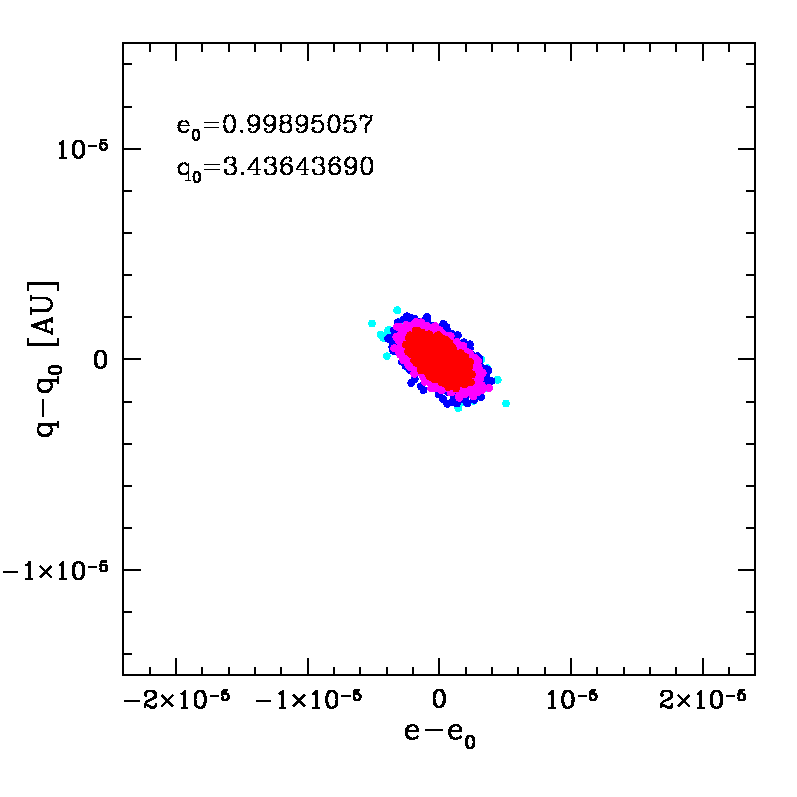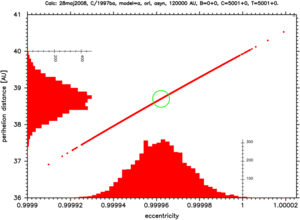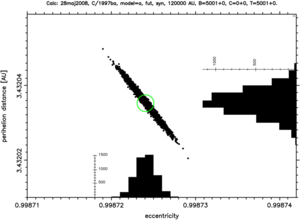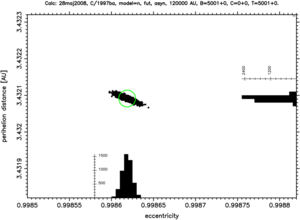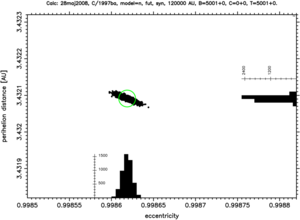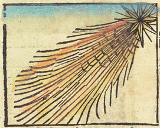Nongravitational nominal solution
Observational arc: 1997 01 11 - 2004 09 15 Number of observations: 529 RMS: 0.67 arcsec (1054 residuals used, 0.4% rejected residuals )
Heliocentric osculating orbit
Epoch Perihelion time q e ω Ω i
1999 12 08 19991127.566151 3.43630558 0.99882316 285.935698 317.663829 72.714861
± 0.000334 0.00000451 0.00000508 0.000033 0.000010 0.000022
NG parameters:
A1 = (3340.8 ± 117.7 )×10-8 AU/day2
A2 = ( 24.282 ± 54.541)×10-8 AU/day2
A3 = ( -29.81 ± 11.72 )×10-8 AU/day2
Barycentric nominal original orbit (at 250 AU from the Sun)
Epoch Perihelion time q e ω Ω i
1697 02 13 19991128.142457 3.44037125 0.99989050 285.890502 318.382446 72.634463
± 0.000383 0.00000573 0.00000397 0.000150 0.000014 0.000027
1/aori = (+31.83 ± 1.15)×10-6 AU-1
Barycentric nominal future orbit (at 250 AU from the Sun)
Epoch Perihelion time q e ω Ω i
2307 02 17 19991128.384619 3.43278727 0.99861836 285.870734 318.286367 72.679266
± 0.000418 0.00000591 0.00000589 0.000186 0.000012 0.000028
1/afut = (+402.48 ± 1.72)×10-6 AU-1
In the 17th edition of the Catalogue of Cometary orbits (2008):
Gravitational orbit (418 obs.) with 1/aori = 0.000000 AU-1.
The same comet in some other internet sources:
More details
Starting swarms of VCs...(heliocentric, osculating orbits)
Original and future orbit at the 250 AU from the Sun.
Comet number 18 in the Table: Nongravitational Oort spike comets (26 objects)
| Name | GR (1/a)ori [10-8 AU/day2] | GR (1/a)osc [10-8 AU/day2] epoch [TT] | GR 1/afut [10-8 AU/day2] | RMSGR [arcsec] | NG (1/a)ori [10-8 AU/day2] | NG (1/a)osc [10-8 AU/day2] epoch [TT] | NG 1/afut [10-8 AU/day2] | RMSNG [arcsec] | NG parameters A1 A2 A3 [10-8 AU/day2] tau shift [day] | |
| 18 | C/1997 BA6 Spacewatch weighting | +1.49 ± 0.35 | +305.38 ± 0.35 1999 12 08 | +371.77 ± 0.35 | 0.74 | +31.83 ± 1.15 | +342.47 ± 1.48 1999 12 08 | +402.48 ± 1.72 | 0.67 | 3340.8 ± 117.7 24.3 ± 54.1 -29.8 ± 11.7 |
Note: in the following plots black denotes returning clones while red denotes escaping ones.The nominal solution is located at the center of the green circle. Each plot have a header where date of calculation and some other parameters are coded. Also numbers of returning (B=shown+omitted), escaping (C=shown+omitted) and all (T=shown+omitted) Vcs are shown.
Past orbits, at previous perihelion for the returning VCs :
Future orbits, at next perihelion :
